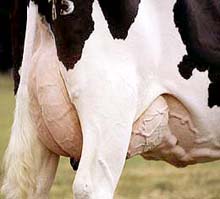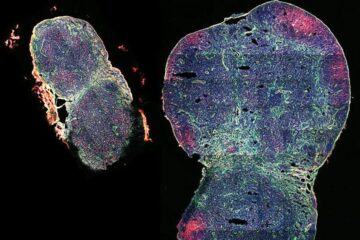Breeding mastitis out of the dairy herd

New technology developed by CSIRO Livestock Industries (CLI) will lead to the development of new strategies designed to substantially reduce the $140 million lost each year due to Australian dairy cows contracting udder infections.
Developed with support from the Innovative Dairy Products Cooperative Research Centre (Dairy CRC), the bovine immune gene microarray provides researchers with the means to rapidly assess the gene activity profiles of infected and mastitis-resistant cattle.
“Mastitis is an infection of the mammary (udder) tissue caused by a range of bacteria,” says CLI’s research team leader, Dr Ross Tellam.
“In dairy cattle this disease results in reduced milk production and altered milk quality and costs Australian dairy farmers between $120 and $150 per cow to treat.
“Identifying the genes responsible for resistance or susceptibility to mastitis opens up the possibility of selecting and breeding dairy cattle with an increased natural resistance to the disease,” Dr Tellam says.
According to the Dairy CRC’s Chief Executive Officer, Dr Paul Donnelly, it is desirable that the industry develops approaches to managing mastitis which reduce the dependence on antibiotics.
“Reducing the incidence of mastitis through improved genetics will lessen costs to individual farmers and improve animal welfare,” Dr Donnelly says.
The research is part of the Dairy CRC’s Gene Discovery Program which aims to identify, isolate and determine the function of specific dairy cow genes.
More information:
Ross Tellam, 07 3214 2476, mobile: 0409 775 044CSIRO Livestock Industries
For information on the Dairy CRC visit: www.dairycrc.com
Media assistance:
Veronica Toohey, 07 3214 2960, mobile: 0408 096 723
CSIRO Livestock Industries
Gabrielle Sheehan, 03 9607 8608, 0409 945 001
Dairy CRC
Media Contact
More Information:
http://www.csiro.au/index.asp?type=mediaRelease&id=PrmastitisAll latest news from the category: Agricultural and Forestry Science
Newest articles

Red light therapy for repairing spinal cord injury passes milestone
Patients with spinal cord injury (SCI) could benefit from a future treatment to repair nerve connections using red and near-infrared light. The method, invented by scientists at the University of…

Insect research is revolutionized by technology
New technologies can revolutionise insect research and environmental monitoring. By using DNA, images, sounds and flight patterns analysed by AI, it’s possible to gain new insights into the world of…

Expanding a lymph node, boosting a vaccine
A biomaterial vaccine enhances and sustains lymph node expansion following vaccination, boosting anti-tumor immunity in an animal model. Each one of us has around 600 lymph nodes (LNs) – small,…





















